The February current population survey unemployment report is just plain weird and it is not due to weather. First, the unemployment rate is an artificial 6.7%. The unemployment rate increased by 0.1 percentage points due to more people being officially counted as unemployed. Yet, the employment level is basically static, almost unchanged from last month, along with the labor participation rate. The ranks of the employed has increased 1.8 million over the past year while the official unemployed has declined by almost 1.6 million.

This article overviews and graphs the statistics from the Employment report Household Survey and the labor statistics look almost frozen and static. This survey does actually give an estimate of the people not working due to bad weather, the favorite thing to blame recently when economic statistics are horrific. The household survey counts people not at work due to bad weather as employed. The January to February change did jump in comparison to past years and was 339 thousand more Yet the figure pales in comparison to the January to February 2010 and 2011 changes. If people went to part-time hours for weather, that too is counted as part-time for non-economic reasons. After seasonal adjustment, part-time also was not noticeably impacted by the weather. Bottom line, in spite of people being sucked to the polar vortex from hell in February, in terms of the Household survey it had little impact.
The ranks of the employed increased by 42 thousand this month which is very low. . The employed now tally 145,266,000 as shown in the below graph.
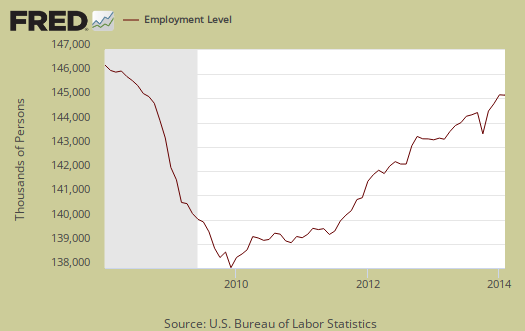
Those unemployed stands at 10,459,000, a 223,000 increase from last month and a main reason why the unemployment rate ticked up by 0.1 percentage points. Below is the change in unemployed and as we can see, this number normally swings wildly on a month to month basis generally. A sudden increase in the ranks of the official unemployed for one month really isn't enough to indicate a trend.
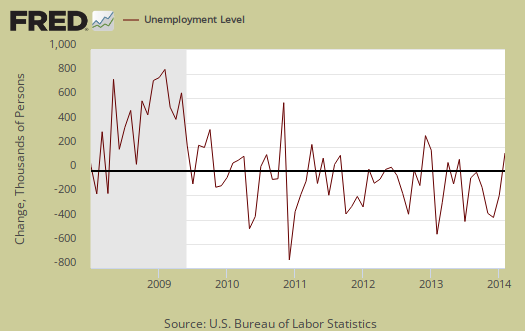
Those not in the labor force decreased by -94,000 persons. The below graph is the monthly change of the not in the labor force ranks. Notice the increasing swells and wild monthly swings. Those not in the labor force has increased over two million in the past year. These are not all baby boomers and people entering into retirement as we showed in this analysis of labor participation by age.
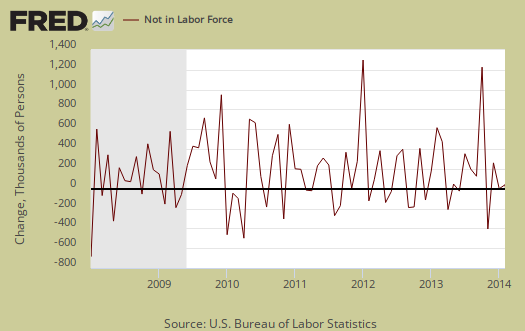
The most frightening statistic of the household survey is the labor participation rate. The labor participation rate remained the same as last month, 63%. . For those claiming the low labor participation rate is just people retired, we proved that false by analyzing labor participation rates by age and bear in mind one must take BLS data at annual intervals, else the January only population adjustments with throw off any analysis. Bottom line, the dramatic increase of those not in the labor force is not just due to baby boomer's retiring, although depending on the time interval chosen, the ratios of people just not finding jobs and dropping off of the unemployed radar map or not entering the labor force altogether versus the retired change.
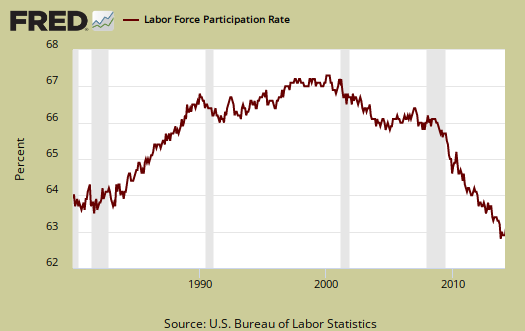
The civilian labor force, which consists of the employed and the officially unemployed, increased by 264 thousand this month. The civilian labor force has increased by 213,000 over the past year. This shows a static situation for we know new workers enter the labor force every day from increased population growth. It is not simply that the unemployed became employed again.
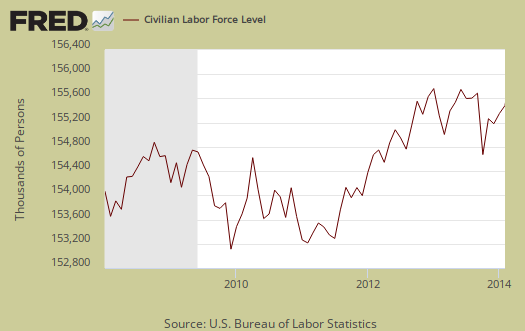
In spite of wild statistical swings, those not in the labor force grows faster than the population which has the potential to work. Below is a graph of those not in the labor force, (maroon, scale on the left), against the noninstitutional civilian population (blue, scale on the right). Notice how those not in the labor force crosses the noninstitutional civilian population in growth and the accelerated growth started happening right in 2008. There were not enough babies born starting in 1943 to explain the steep 2008 and beyond increase.

Below is a graph of the civilian labor force, or the official employed plus unemployed, in maroon, scale on left, against those not in the labor force, in blue, scale on right. Notice how those not in the labor force as a trend exceeded those considered employed and unemployed starting around mid 2009. What we have seen is a never ending growing segment of the population that is considered neither employed or unemployed, i.e. not in the labor force, increasing, above the trend line of those who would be naturally dropping out, such as the retired and those in school. Not in the labor force figures do include retirees and the size of the population greater than age 65 has grown.
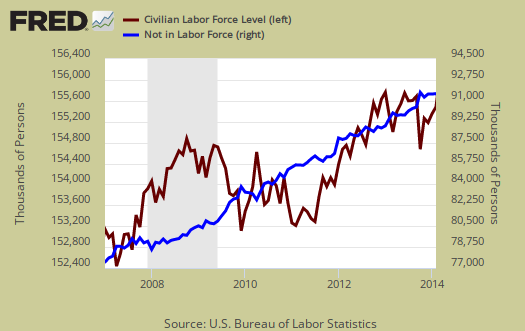
Those considered employed as a ratio to the total Civilian noninstitutional population had no change and stand at 58.8%. This reflects the static nature of this month's statistics Generally speaking the employment to population ratio has been hovering around 1983 record lows for years now and in 1983 there were more families with a stay at home mom, with wages high enough for only one adult to work and support a family and a very steep recession. The low ratio implies there are many people who could be part of the labor force are not anymore, as shown in the graph below. For the interested, there is a relationship between the employment-population ratio and the labor participation rate (LPR): employment-population ratio = LPR * (1 - unemployment rate).

There are millions of people who need full-time jobs with benefits who can't get decent career oriented positions. Those forced into part time work is now 7,186,000, an decrease of -71,000 from last month. Those stuck in part-time hours has declined by -804 thousand from a year ago. The below graph shows levels of people who could only get part time hours have remained elevated since the recession and these are all people who want full-time, they just cannot get it, it is not by choice, although a -10% drop in a year is a positive step in the right direction.

There are two categories of those working part-time hours. Those who could only get part-time jobs and those working who got their hours cut due to businesses not having enough work for them. The number of people who could only get part-time work increased by 121 thousand to 2,692,000. The number of people who could only find part-time work is shown in the below graph and from a year ago has not budged.

People can also be stuck with part-time hours due to slack working conditions. This figure has remained just obscenely high for years now and this month stand at 4,251,000 From a year ago those who are getting their hours slashed due to weak economic demand has declined by -17%. Below is a graph of forced into part-time work because they got their hours cut, as a percentage of the total employed. Part-time work due to cut hours is known as slack work conditions. Slack working conditions causing part-time hours remaining high or increasing implies economic conditions have not improved enough, that there still is just not enough demand in the economy for businesses to run full steam. Below is a graph of forced part-timers due to slack work conditions as a percentage of the civilian labor force. This is a recession economic indicator, notice the line slope matches strongly the gray recession bars of the graph. In other words, part-time work due to a crappy economy has clearly improved over the last year.
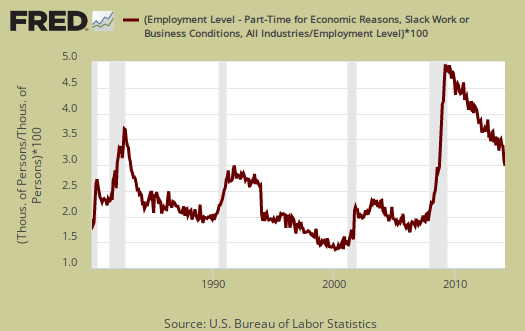
U-6 is a broader measure of unemployment and includes the official unemployed, people working part-time hours because that's all they can get and a subgroup not counted in the labor force but are available for work and looked in the last 12 months . The U-6 alternative unemployment rate still leaves out some people wanting a job who are not considered part of the labor force. U-6 stands at 12.6%.
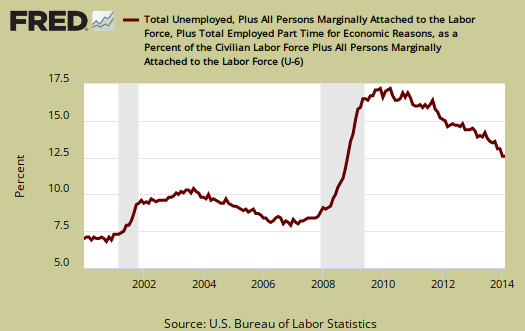
The long term unemployed, or those unemployed for 27 weeks and over, increased by 203 thousand and stands at 3,849,000 people. The long term unemployed are the crisis of our time and we know these people did not get jobs since the ranks of the employed gained less than the decline in the long term unemployed. From a year ago the long term unemployed ranks have decreased by -19%, but this does not mean at all these folk found work.

The marginally attached are people not in the labor force because they have not looked for a job in the last month, but have looked for a job in the last year. This number has ballooned since 2007 and not returned to pre-recession levels. The graph below is the number of people considered marginally attached to the labor force, currently at 2.303 million. The marginally attached should only be viewed as a long term trend for the figures are also not seasonally adjusted.

Discouraged workers are people, not counted as part of the civilian labor force, who not only want a job, but also looked for one in the last year. These people aren't job hunting now because they believe there are no jobs out there. Below is the graph of discouraged workers, currently at 755,000 people and are a subset of the marginally attached. Discouraged workers is kind of a barometer for how the job market is perceived. From a year ago workers discouraged has declined by 11.7%. In other words this figure really isn't dropping much.

Our favorite statistic from the CPS survey is how many people who are considered not in the labor force, report they want a job now. It is a direct survey question from the CPS. The survey asks people who are not being counted in the unemployment statistics and official unemployment rate if they want a job. The number who answer yes currently stands at 6,060,000, a very large number of people. Those who are not counted yet report they want a job includes the discouraged workers and marginally attached and is seasonally adjusted.

The average length of unemployment is 37.1 weeks. The average duration is so high due to the long-term unemployed who represent 37% of the unemployed. Many long term unemployed face age discrimination as well as discrimination for the fact they need a job, one of the worst injustices in America.

The median time one is unemployed, which means 50% of people have gotten a job in this amount of time, and is 16.4 weeks. This is over four months to be without a paycheck as the median, and even after that length of time 50% of the people still can't find work.
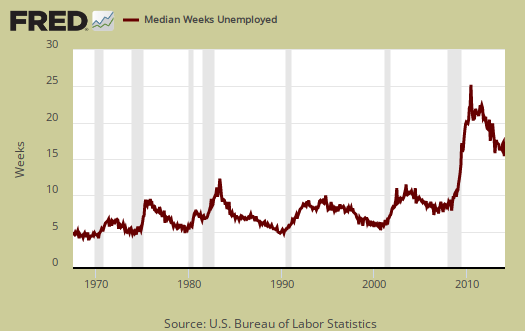
Those unemployed less than five weeks declined by -61 thousand from last month. Those unemployed between five weeks and 14 weeks increased by 139 thousand and people who had been unemployed for 14 weeks to 26 weeks declined by -74,000. As previously noted, the long term unemployed increased by 203 thousand. . A drop in the unemployed does not necessarily mean they found a job.
The household survey gives the reason for new unemployment status. Job losers and those who completed temporary jobs is still the majority and stands at 5,448,000. Below is a graph of job losers by levels. While the figure has dropped dramatically it is still higher than any other recession. In other words people are still losing their jobs as a pattern in comparison to before 2008.

People join the ranks of the unemployed because they were laid-off, fired, they quit, the job was temporary and thus ended, they entered the labor force for the first time and re-entrants. Re-entrants are people with work experience, yet have been considered not in the labor force for some time. Recall to be considered unemployed one has to be actively searching for a job or expecting to be recalled and on temporary layoff. Re-entrants increased by 60 thousand people this month. Below are re-entrants as a percentage of the total unemployed. As you can see, as jobs and opportunities appear, people re-enter the labor force looking to snap one of those jobs. Considering the massive damage still to the U.S. job market, the below tells us things really have not improved enough. If there were really a lot of job opportunities out there, the slope of this graph would spike up and should spike up to the extremes since there are so many who have stopped looking, are not counted as unemployed currently, who could re-enter the labor market.
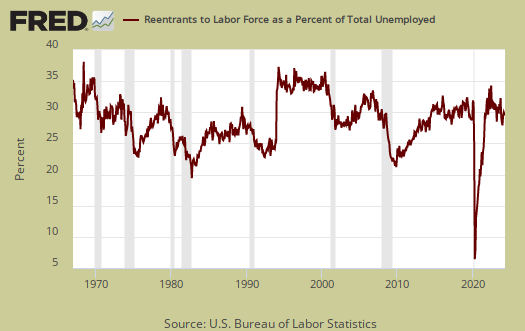
Re-entrant unemployed levels are yet another sign on how people are not finding work, giving up, then dropping out of the labor force and then trying again to get a job. If the job market was good for a long period we'd see this statistic drop as new entrants would have found work instead of being once again officially counted as unemployed.
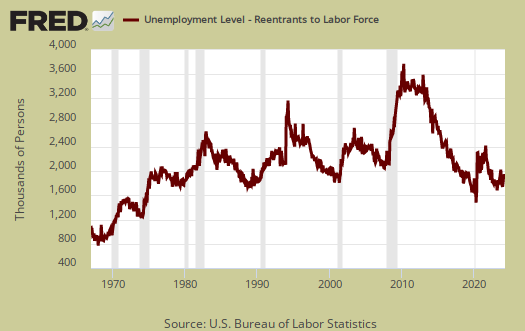
To sum up this month's household survey, it's just business as usual, a weak employment situation for people once again with no dramatic change.
Here is our past overviews CPS unemployment statistics.

We might have had 0% unemployment
Excellent, thorough and accurate description of the current job market — thanks.
According to Labor Secretary Perez: "For four years uninterrupted now — 48 consecutive months — private-sector employment has grown, to the tune of 8.7 million new jobs."
According to the Economic Policy Institute, we are now DEAD EVEN, because over the last four years the labor market has gained back all of the 8.7 million jobs we lost during the Great Recession.
Now if only the population had not grown, and we had no new graduates attempting to enter the labor force, or we didn't have any new questworkers imported here on visas, or we didn't have any more offshoring of jobs—maybe every single person who was laid off during the Great Recession would have been rehired (re-entrants) — and we'd have 0% unemployment.
When you mention discouraged workers, "These people aren't job hunting now because they believe there are no jobs out there"— I would say it's because they can't find something if it doesn't exist—and to continue searching for non-existent jobs only proves Einstein definition of insanity: Doing the same thing over and over again and expecting different results.